Stilt.Pro Equipment Rolls Out Rice Hull Blower
With the ever-increasing cost of chemicals and ever-decreasing supply of labor to hand weed any preemergence escapes, a lot of growers are looking for ways to stretch weed control in container operations. Well, last summer I saw an interesting prototype system to apply rice hulls to containers, developed by Stilt.Pro. My first thought was that this is perfect for situations whereby just potted plants have that two-week window before preemergence herbicides can be applied. Of course, any mulch also reduces weed pressure by depriving the weed seed of an environment conducive to germination and growth.
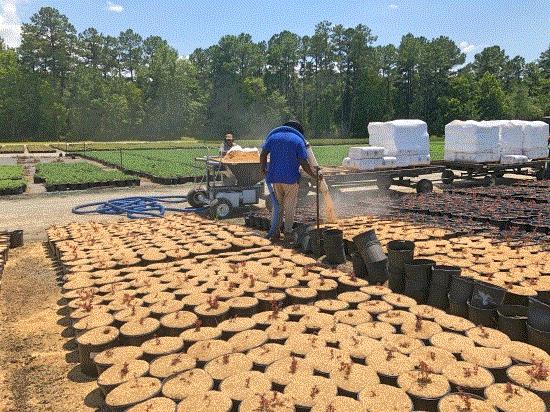
Fast forward to a few weeks ago when I learned that the Rice Hull Blower had been commercially released (their video is way better than mine). I was pretty excited to see this, as it's the very first in-field blower-style applicator (that I'm aware of). It’s a simple design, made to last, and was designed with a heavy dose of grower-input. A two-man crew can apply the product at a rate less than 8 cents per pot (all-in cost). That’s pretty darn good in my humble opinion. Well done, Stilt.Pro!

Die-camba … Die
In what is a good move for many ornamental producers and landscape contractors that have (literally) gotten burned by Dicamba drift from agronomic operations, a Federal Court ruling this week effectively banned the use of Dicamba in the United States. As with all court rulings, it’s never over until the Supreme Court either fails to see or rules on a case, but things are looking bleak for Dicamba lovers right now.
And while a lot of ornamental growers in particular have suffered tremendous losses due to Dicamba drift, its eventual fate is long from sure. For example, the U.S. Environmental Protection Agency just Wednesday of this week put out a memo saying that they'll allow use of Dicamba products purchased before June 3 until July 31. The national Farm Bureau Association is beating down the new fence around the White House to get the President involved and many farmers say they'll use what they have until it runs out, to heck with the EPA and their arbitrary dates.
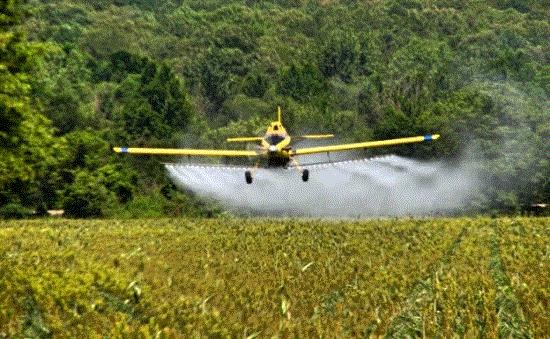
Dicamba aerial application. Photo courtesy of the University of Tennessee Institute of Agriculture.
The official statement by U.S. Secretary of Agriculture Sonny Perdue sums up the mood of government, when he stated, “Producers need all the tools in their toolbox to produce the world’s food, fuel and fiber, and USDA re-affirms its support for EPA’s science-based process for assessing and managing ecological risks, balanced against the agricultural and societal benefits of crop protection tools. USDA stands ready to assist its federal partners in meeting that goal. Farmers across America have spent hard-earned money on previously allowed crop-protection tools. I encourage the EPA to use any available flexibilities to allow the continued use of already purchased Dicamba products, which are a critical tool for American farmers to combat weeds resistant to many other herbicides, in fields that are already planted. Unfortunately, the Ninth Circuit has chosen to eliminate one of those tools.”
One thing is for sure—what’s generally seen as good for the Green Industry (if this ruling holds) is going to significantly impact our agronomic crop brothers and sisters in yield and profitability. As always, I’ll keep up with the saga and report back with further news.

Plant of the Decade
I don’t know about you folks, but my favorite plant changes nearly by the hour, so when I see “Plant of the Decade” it tends to draw my attention. First, 10 years is a LONG time. (Heck, May felt like 10 years and I don’t even remember March!)
Nonetheless, the Royal Horticultural Society recently narrowed down a semifinalist list of 10 taxa to a single winner. And that winner is … Viburnum plicatum f. tomentosum Kilimanjaro Sunrise.
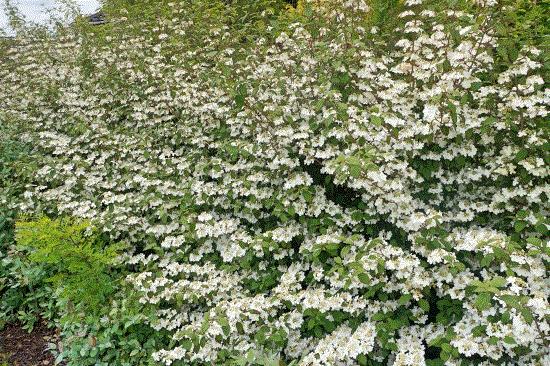
I must admit, it looks good in full bloom.
Okay, so I gotta admit, they did pick a heck of a viburnum cultivar there. Known for its multi-stemmed, upright, compact, slow-growing habit, Kilimanjaro Sunrise sports pretty, blush-pink, lacecap-like flowers, blooming abundantly in both spring and summer. In fall, the leaves turn fiery autumn hues, providing outstanding seasonal interest. Kilimanjaro Sunrise reaches 6-ft. tall and 2-ft. wide, making it suitable as a flowering hedge, garden border or attractive specimen shrub in the garden. In North America, it’s hardy in USDA Zones 5 to 8 and should be grown in moist soils.
In the U.S., Concept plants holds licensing rights.
“We’re thrilled to represent Viburnum plicatum Kilimandjaro Sunrise in North America,” says Peter Van Rijssen, partner with Concept Plants. “With its fabulous white spring flowers and summer blush blooms, followed by spectacular autumn color, we’re confident this Plant of the Decade at the RHS Chelsea Flower Show will become a favorite for many home gardeners in North America.”
Growers can expect the first plants to become available in Fall 2021. For more information about Kilimandjaro Sunrise, visit the Concept Plants website.

Remember COVID? Yeah, it’s Still Around
Despite the short-term memory loss currently occurring related to COVID-19, it’s still a serious problem, particularly in agricultural operations. Because agriculture has been hit so hard, the Centers for Disease Control worked with the U.S. Department of Labor to develop guidance for agricultural operations. This is some comprehensive stuff, but worth the read. It’s also worth developing a plan for your business—because businesses that don’t plan don’t often succeed.
You can see the entire guidance document here, but I wanted to share some key concepts identified in the report:
-
Management in the agriculture industry should conduct work-site assessments to identify coronavirus disease 2019 (COVID-19) risks and infection prevention strategies to protect workers
-
Work-site guidance for COVID-19 prevention and control should be taken into consideration in employer-furnished shared worker housing, transportation vehicles and work settings
-
Prevention practices should follow the hierarchy of controls, which includes using source control and a combination of engineering controls, administrative controls (especially proper sanitation, cleaning and disinfection), and personal protective equipment
-
Grouping workers together into cohorts may reduce the spread of COVID-19 transmission in the workplace by minimizing the number of different individuals who come into close contact with each other over the course of a week, and may also reduce the number of workers quarantined because of exposure to the virus
-
Owners/operators should maximize opportunities to place farmworkers residing together in the same vehicles for transportation and in the same cohorts to limit exposure
-
Basic information and training about infection prevention should be provided to all farmworkers in languages they can understand
-
Agriculture worksites developing plans for continuing operations where COVID-19 is spreading among workers or in the surrounding community should work directly with appropriate state and local public health officials, and occupational safety and health professionals

Building a Spotted Lanternfly Trap
Are you tired of making facemasks? Or maybe those wine bottle trees, but using bourbon bottles instead? Well, you’re in luck because the highly productive Penn State Cooperative Extension folks have developed a guide to building traps for the invasive insect Spotted Lanternfly (which a reader reminded me is actually a moth).
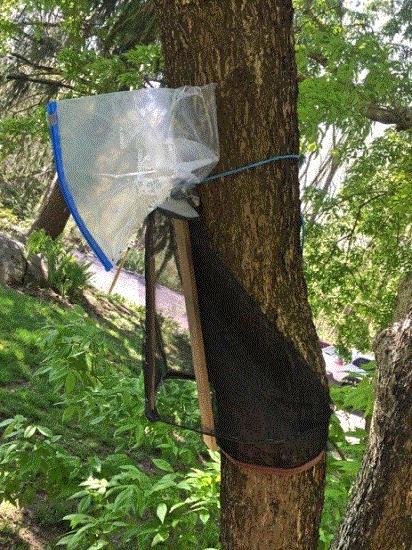
Raid the recycle bin and take a trip to the craft store and you'll have everything you need for this trap. Photo courtesy of Penn State Cooperative Extension.
The Spotted Lanternfly (SLF) is an invasive insect that feeds on grapevines and trees. There are a variety of options for SLF management, but one way to kill a lot of SLF without using insecticides is to trap them. The immature lanternflies (called nymphs) are often blown out of the canopy of the trees where they're feeding. Nymphs then walk to the trunk of trees and climb back up to start feeding again. We can take advantage of this predictable behavior of the nymphs by using traps to catch them as they climb up trees.
The design is quite simple and I doubt would be more than $10 to build, so go have fun building—and death to the dreaded Spotted Lanternfly!

Support Horticulture’s Inclusion in USDA Coronavirus Relief
The USDA’s new Coronavirus Food Assistance Program (CFAP) hasn’t yet extended relief funds to several agricultural sectors, horticulture included. To gather the information necessary to decide whether and how to tailor the program to additional sectors and offer this badly needed assistance, the USDA’s Farm Service Agency has requested public comments on:
-
The coronavirus’ impact on plant prices during the period of January 15 through April 15, 2020; and
-
The value of plant inventory which was sold or ready for sale, but not shipped by April 15, 2020 (due to cancelled orders and market losses) and will not be sold.
AmericanHort has created a simple one-page comment form that will submit your answers directly to the public record that includes guidance on how you should structure comments. You can access the form here. Comments are due by or before June 22!
While many action alerts can be pre-populated, here you must provide your own comments specific to your own nursery/greenhouse. As a reminder, all comments submitted to the Federal Government in the rulemaking process are included in the public record and are accessible to all. For this reason, AmericanHort advises members not to provide confidential business information in any regulatory submissions.
In addition to encouraging industry comments, AmericanHort has a dialogue established with USDA officials to help them understand how our industry was affected, and how access to relief for lost nursery and floriculture crops might best be structured.

Viburnum Island Treasure
What can I say? I can’t let the little Ole’ Royal Horticultural Society show me up with some fancy new viburnum talkin’ about how it’s the best plant in a decade. Hence, I present to you my personal favorite viburnum this week; Viburnum debtatum Island Treasure.
Introduced by Broken Arrow Nursery, this cultivar has a lot going for it. First, it’s hardy from Zones 3b to 9—that’s a wide range, folks (just remember to put it in some afternoon shade). It’s also native to Eastern North America and comes with foliage that has mottled variegation. It blooms nicely in spring as foliage is expanding.
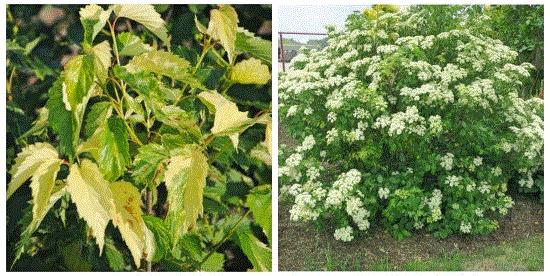
Photos courtesy of the J.C. Raulston Arboretum.
Then, after resting in summer, deep blue fruit take over the show in fall, along with great fall color. If you get an early frost, the fruit will ferment and then you get the added bonus of drunken bird watching.
I will say, if this plant had any negatives, it would be size. It gets pretty big, at 10 ft. rounded (somewhat layered appearance). But if you have a big hole at the back of a bed that gets afternoon shade and doesn’t dry out too much in summer, I think this is an excellent choice.

Our Wacky Wonderful World—Notes from the Edge of Sanity
With all the absolute madness happening in the U.S. (and around the globe for that matter), reading the news or looking at social media has become downright depressing (in fact, I'm quitting Facebook—after giving my peeps two-weeks notice).
Nonetheless, there are a few things that we all need to remember in these trying times. Mainly because they apply to everyday life regardless of if you're interacting with your family, friends, co-workers or a complete stranger.
-
Hurt people—hurt people. Aim to heal with your words and actions, even when others treat you poorly.
-
Don't listen to devise a reply. Listen to learn and accept the lesson graciously.
-
Being wrong isn’t a weakness. Refusing to admit that change is needed … that’s weakness.
-
Surround yourself with people that possess the traits you want to gain or improve upon.
-
And finally, simply treat others the way you want to be treated.
Let’s make this world a more beautiful place (and less hostile).

Live authentic,

Matthew Chappell
Editor-at-Large
Nursery & Landscape Insider
This has been received by 27,670 of the hardest-working horticulturists in show business!
If you're interested in reaching 27,670 (and growing) clients who eagerly await every Nursery & Landscape Insider and surely read every word, contact Kim Brown ASAP and she'll hook you up.